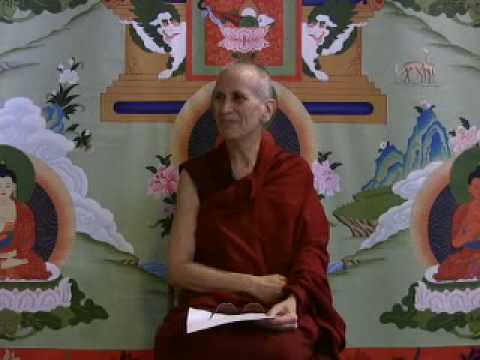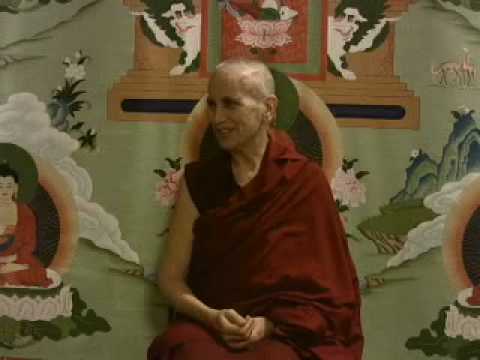Verse 23-2: Mahayana walking meditation
Verse 23-2: Mahayana walking meditation
Part of a series of talks on the 41 Prayers to Cultivate Bodhicitta from the Avatamsaka Sutra (the Flower Ornament Sutra).
- A Mahayana way of walking meditation on bodhicitta
- A Pali way of walking meditation on selflessness
- A Prasangika way of walking meditation on selflessness
41 Prayers to cultivate bodhicitta: Verse 23-2 (download)
We were doing Verses 22 and 23 of the 41 Prayers of the Bodhisattva. Verse 22 is,
“May I walk toward the welfare of all beings.”
This is the prayer of the bodhisattva when placing the foot down.
And Verse 23 is,
“May I lift all sentient beings out of cyclic existence.”
This is the prayer of the bodhisattva when lifting the foot.
There you have a Mahayana version of walking meditation: when you lift the foot you’re lifting sentient beings out of samsara, when you’re placing your foot down you are walking towards the welfare of all sentient beings. The idea is to keep that in our mind as much as we can when we’re walking because if we do that, then we renew the bodhicitta and familiarize the bodhicitta motivation in our mind again and again and again, which is very important.
I was just reading in the Pali canon, when they talk about the four mindfulness practice, there’s a practice when you’re doing mindfulness of the body, when you’re walking, to be aware of moving your feet. Usually I found in this state it’s not just to be aware of moving your feet, I’ve always sensed that there must be more to it than that, so I usually put in watching the dependence of the feet, one upon the other, watching the impermanence of the step. But when I was just studying about it in the Pali commentaries they talk about actually meditating on selflessness as they see selflessness during the time that you’re walking. So you’re breaking down all the little moments of the body into different moments, different parts of the body that are walking, and breaking down all the moments of time of walking into individual parts, and breaking down your intention to walk into individual mind moment and in examining all of these things, whether they are the body or the mind, seeing that there’s no self in them.
That’s the principal way, in the Pali tradition, that you meditate on selflessness is really getting very refined awareness of different parts of the body, different moments of mind, and seeing there’s no self in them. So in thinking about that way of meditating on selflessness—and here we have a way of developing bodhicitta when walking, lifting sentient beings out of samsara, walking towards their welfare—we see that what is common in the whole thing is not to let a moment go by without applying the Dharma to what we’re doing.
Whether we’re meditating on selflessness or generating bodhicitta, the idea is, each moment in our life, to have a Dharma awareness so that we’re using everything that we’re doing in our life to bring us back to some Dharma understanding, whether it’s the understanding of bodhicitta or the understanding of selflessness.
That’s getting us back to what they call, “Dharma in daily life.” Which is actually very difficult, isn’t it? It’s hard enough to realize what emotions we’re feeling at the time we’re feeling them and to deal with those gross things, let alone remember when we’re walking—either to walk with bodhicitta or walk with a mind investigating selflessness.
Lama Zopa has a way of walking where you’re investigating selflessness, asking, “Who is walking?” and seeing that we only say “I’m walking,” because the body is walking. So it’s in dependence upon the body that we’re labelling “I” and therefore we say “I’m walking.” Other than being merely labelled in dependence upon the body and mind, there is no “I” that is walking. So that’s showing a Prasangika way of meditating on selflessness when we’re walking. But the idea is, whatever we’re doing to try and have some Dharma awareness during that time.
That already takes a lot of mindfulness and a lot of this mental factor that we still don’t have a good translation for. Now I’m playing with “checking introspection” or “introspective checking. Samprajnata is the Sanskrit term. It actually makes just as much sense as any of the translations we’ve come up with.
Venerable Thubten Chodron
Venerable Chodron emphasizes the practical application of Buddha’s teachings in our daily lives and is especially skilled at explaining them in ways easily understood and practiced by Westerners. She is well known for her warm, humorous, and lucid teachings. She was ordained as a Buddhist nun in 1977 by Kyabje Ling Rinpoche in Dharamsala, India, and in 1986 she received bhikshuni (full) ordination in Taiwan. Read her full bio.


